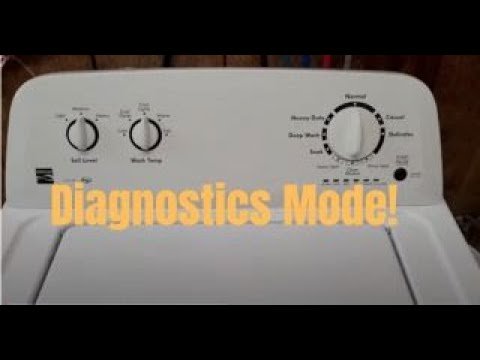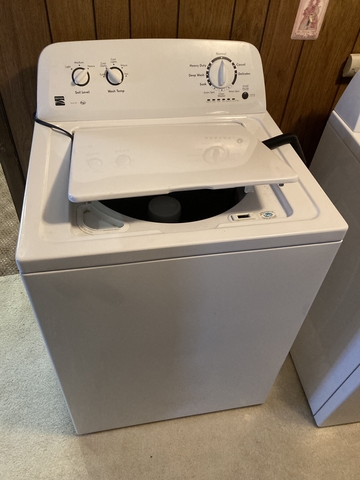
Kenmore Series 100 washer troubleshooting can be done by following simple steps to identify and resolve common issues. Introducing the Kenmore Series 100 Washer Troubleshooting Is your Kenmore Series 100 washer acting up?
Troubleshooting common problems can help you save time and money. Whether it’s a spinning issue, a leaking problem, or an error code on the display, understanding how to troubleshoot your washer is essential. In this guide, we will walk you through simple steps to diagnose and fix common issues with your Kenmore Series 100 washer.
By identifying the root cause and applying the correct solutions, you can keep your washer running smoothly and avoid unnecessary repairs. Read on to discover effective troubleshooting techniques for your Kenmore Series 100 washer.

Credit: m.youtube.com
Common Issues
The Kenmore Series 100 washer is renowned for its reliability and efficiency. However, like any other appliance, it is not immune to occasional hiccups. In this section, we will delve into the common issues that users may encounter with the Kenmore Series 100 washer, including machine not starting, noisy operation, and drainage problems. By understanding these issues and their troubleshooting methods, you can ensure a seamlessly functioning washer that consistently delivers clean and fresh laundry.
Machine Not Starting
A frustrating scenario many users face is when their Kenmore Series 100 washer refuses to start. This can leave you with a pile of dirty laundry and a sense of helplessness. Fortunately, there are a few troubleshooting steps you can take to resolve this issue:
- Check the power supply: Verify that your washer is properly connected to a functional power outlet and that the circuit breaker has not tripped.
- Inspect the control panel: Make sure the selected wash cycle and options are appropriate for the load. Also, ensure that the door or lid is securely closed, as the machine will not start if it senses an open door.
- Reset the machine: Power off the washer, unplug it, wait for a few minutes, and then plug it back in. This simple reset may resolve any minor glitches that are hindering the machine’s startup.
If following these troubleshooting steps does not solve the issue, it is recommended to consult the Kenmore Series 100 washer’s user manual or contact the manufacturer’s customer support for further assistance.
Noisy Operation
A Kenmore Series 100 washer is designed to operate quietly, so if you notice unusual noises during a wash cycle, it is important to address the issue promptly. Noisy operation can be indicative of several underlying problems. Here’s how you can troubleshoot and resolve this issue:
- Balance the load: An unevenly distributed load can cause the washer to vibrate excessively and produce loud noises. Ensure that the load is evenly spread across the drum.
- Check for foreign objects: Inspect the drum for any loose items, such as coins or small articles of clothing, which can create a rattling sound during operation.
- Inspect the leveling feet: Ensure that the washer’s leveling feet are properly adjusted and in contact with the floor, as an unbalanced washing machine can result in noisy operation.
- Service the machine: If the above steps do not resolve the issue, it may be necessary to have the washer serviced by a professional technician to address any mechanical or motor-related problems.
Drainage Problems
A Kenmore Series 100 washer relies on effective drainage for optimal performance. If you encounter drainage issues, such as water not draining properly or standing water in the drum, follow these troubleshooting steps:
- Check the drain hose: Ensure that the drain hose is not kinked, clogged, or obstructed in any way. Straighten the hose if necessary and clean any debris or lint from it.
- Inspect the drain filter: Locate the drain filter, usually found near the bottom front of the washer, and remove any debris or lint that may be clogging it.
- Verify the drain pump: Check the drain pump for any signs of damage or blockage. Clear any obstructions and ensure that the pump is functioning properly.
- Elevate the drain hose: If the drain hose outlet is positioned too low or below the recommended height, it can impede proper drainage. Raise the hose to the recommended height to facilitate smooth water flow.
By addressing these potential drainage problems, your Kenmore Series 100 washer can regain its optimal performance and efficiently eliminate water from your laundry load.
Troubleshooting Steps
Is your Kenmore Series 100 Washer acting up? Don’t fret! Troubleshooting the issue can often save you time and money by avoiding a costly repair or replacement. In this section, we will walk you through the essential troubleshooting steps to get your washer back up and running smoothly.
Checking Power And Connections
Before diving into the more complex troubleshooting steps, it’s crucial to check the power and connections of your Kenmore Series 100 Washer. Here’s how:
- Ensure the power cord is securely plugged into a working electrical outlet. Sometimes, a loose connection may prevent the washer from functioning.
- Inspect the circuit breaker or fuse box to confirm that the circuit breaker hasn’t tripped or the fuse hasn’t blown. If it has, reset the breaker or replace the fuse.
- Examine the power cord for any visible damage such as frays or cuts. If you spot any, it may be necessary to replace the power cord with a new one.
- Double-check the water supply hoses connected to your washer. Ensure they are firmly attached and not kinked, twisted, or damaged.
- Inspect the drain hose to make sure it is properly connected and not clogged.
- Verify that there are no loose wires or connections within the control panel of the washer.
Inspecting For Obstructions
If your Kenmore Series 100 Washer is still experiencing issues after checking the power and connections, it’s time to move on to inspecting for obstructions. Here’s what you should do:
- Remove any garments or objects from the washer drum that may be causing an obstruction.
- Check the washer door or lid to ensure it is securely closed. A loose or improperly closed door or lid can prevent the washer from operating.
- Examine the water inlet screens on the water supply hoses for any debris or sediment. If clogged, clean the screens thoroughly to restore proper water flow.
- Inspect the drain pump filter for any blockages or debris. Cleaning the filter can often resolve drainage issues.
- If your washer has a coin trap, locate and clean it to remove any accumulated coins, lint, or small objects that may impede its function.
Testing And Replacing Components
If neither power issues nor obstructions seem to be the cause of your Kenmore Series 100 Washer’s malfunction, it may be necessary to test and replace certain components. Consider the following:
- Perform a diagnostic test cycle to identify any error codes displayed on the control panel. These error codes can help troubleshoot the specific problem.
- Test the lid switch by manually engaging it with a pen or small object while the washer is running. If the washer starts working when the switch is manually engaged, it may need replacement.
- Inspect the water inlet valve for any signs of leaks or malfunctions. A faulty valve can hinder water flow or cause leaks.
- Check the motor coupler, belts, and pulleys for signs of wear, damage, or misalignment. These components are vital for the washer’s proper functioning and may require replacement if faulty.
- Consider testing electrical components such as the motor, timer, and control board using a multimeter. Faulty electrical components may need professional repair or replacement.
By following these troubleshooting steps, you can gain a better understanding of what might be causing the issue with your Kenmore Series 100 Washer. Remember, if you’re unsure or uncomfortable performing these steps, it’s always recommended to seek the assistance of a qualified technician or contact Kenmore’s customer support for further guidance.
Preventive Maintenance
Proper preventive maintenance is crucial for keeping your Kenmore Series 100 Washer in optimal condition. By following a few simple steps, you can ensure that your washer performs efficiently and avoids potential breakdowns or malfunctions. In this section, we will discuss some important aspects of preventive maintenance for your Kenmore Series 100 Washer.
Regular Cleaning And Maintenance
Regular cleaning and maintenance is essential to keep your Kenmore Series 100 Washer functioning effectively. Here are some tips on how to maintain a clean and well-maintained washer:
- After each use, wipe down the interior and exterior of the machine with a damp cloth to remove any residue or dirt.
- Inspect the drum and gasket for any signs of mold or mildew. If you notice any, clean them with a mixture of water and mild detergent.
- Ensure that the drain pump filter is free from debris by checking and cleaning it regularly. A clogged filter can lead to poor drainage and potential problems with the washer’s performance.
- Examine the hoses for any signs of wear or damage. Replace them if necessary to prevent leaks or water damage.
Proper Loading And Balancing
One of the main causes of washer issues is improper loading and balancing. Follow these guidelines to ensure that you load your Kenmore Series 100 Washer correctly:
- Separate your laundry according to fabric type, color, and weight. This will help maintain a balance during the wash cycle.
- Avoid overloading the washer. Overloading can strain the machine and reduce its efficiency. Follow the manufacturer’s guidelines for the maximum load capacity.
- Distribute the clothes evenly inside the drum. Unevenly distributed laundry can cause the washer to become unbalanced, leading to excessive vibrations and potential damage to the machine.
Using Appropriate Detergents
Choosing the right detergent for your Kenmore Series 100 Washer is essential to safeguard its performance and longevity. Consider the following when selecting a detergent:
- Use high-quality detergents that are formulated for high-efficiency washers.
- Avoid using excessive amounts of detergent as it can lead to residue buildup and reduce the machine’s effectiveness.
- Consider using eco-friendly or hypoallergenic detergents if you or your family members have sensitivities or allergies.

Credit: www.tiktok.com

Credit: www.nextechclassifieds.com
Frequently Asked Questions Of Kenmore Series 100 Washer Troubleshooting
How Do I Troubleshoot My Kenmore Series 100 Washer?
To troubleshoot your Kenmore Series 100 washer, start by checking the power supply, ensuring the washer is level, and inspecting the water supply. You can also run diagnostic tests and clean the filter to help identify and resolve common issues.
Why Is My Kenmore Series 100 Washer Not Starting?
If your Kenmore Series 100 washer is not starting, check if it’s properly plugged in and if the circuit breaker is tripped. Additionally, ensure the door or lid is closed securely and the water supply is turned on. If the problem persists, consult the user manual or contact customer support.
How Can I Resolve Excessive Noise During The Wash Cycle?
To address excessive noise during the wash cycle on your Kenmore Series 100 washer, check if the load is balanced and not overloaded. Inspect for any foreign objects trapped in the drum or under the washer. Level the machine and ensure it’s on a stable surface.
If the noise persists, seek professional assistance.
Conclusion
If you’re facing issues with your Kenmore Series 100 washer, troubleshooting it can save you time and money. By following these steps, you can easily fix common problems and avoid unnecessary repairs. Remember to check the power supply, water inlet valves, and drainage system to ensure smooth operation.
Regular maintenance and proper care will extend the lifespan of your appliance. Stay proactive, and tackle any issues promptly to keep your Kenmore Series 100 washer running smoothly for years to come.






